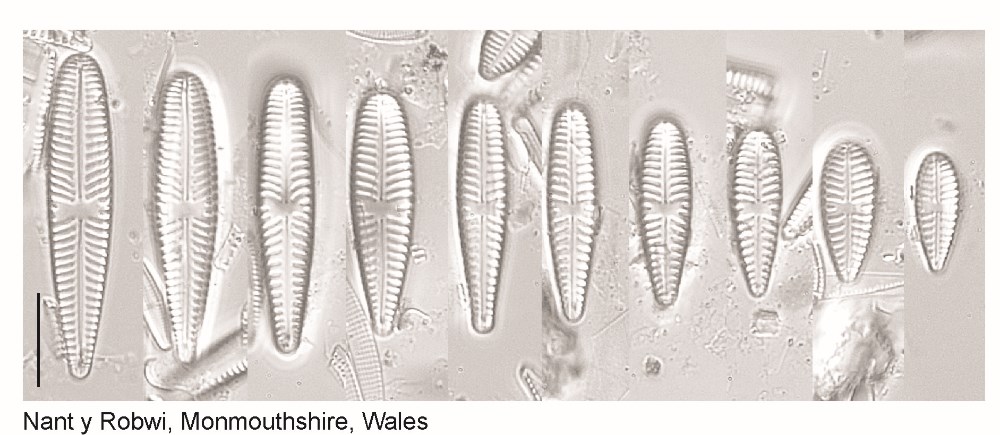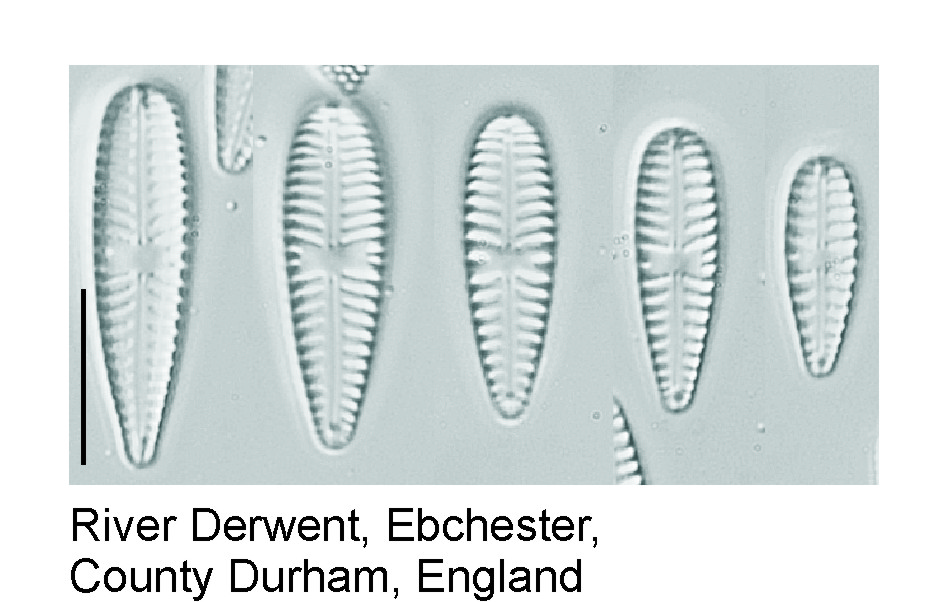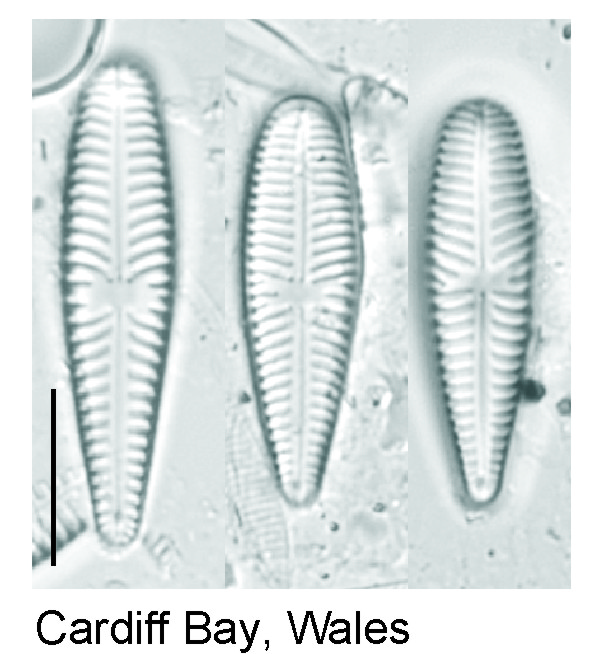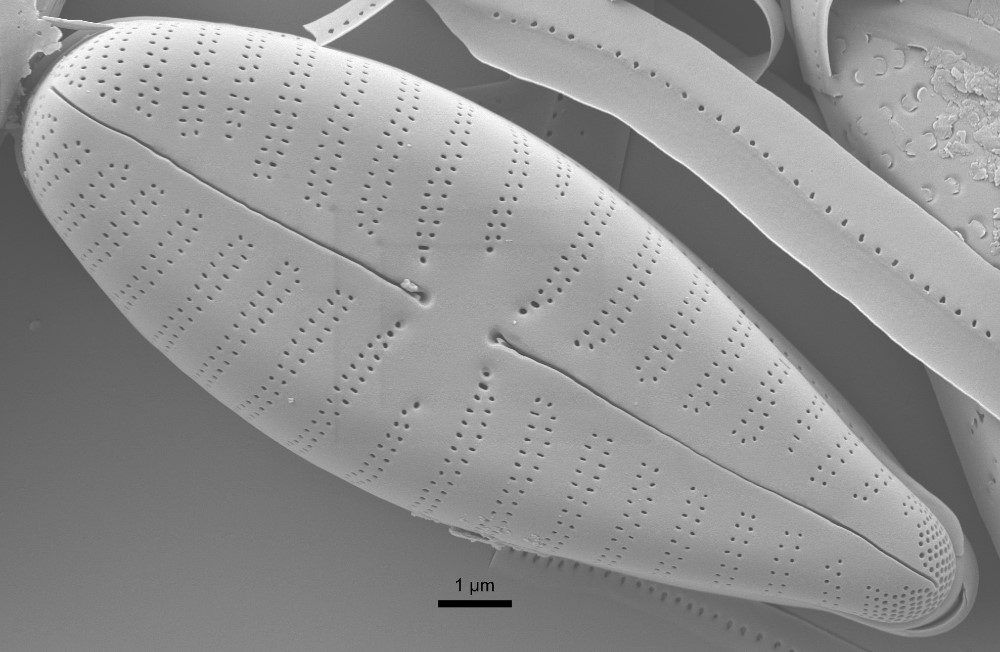Gomphonema olivaceum (Hornemann) Brébisson; 1838; 218
Key references
Jahn R., Kusber W.-H., Skibbe O., Zimmermann J., Van A.T., Buczko K., Abarca N. 2019. Gomphonella olivacea (Bacillariophyceae) - a new phylogenetic position for a well-known taxon, its typification, new species and combinations. Plant Ecology and Evolution. 152(2): 219-247.
Morphology
Shape
Elliptical with broadly rounded head pole, narrowing to a more acutely rounded foot pole.
Symmetry
Heteropolar, bilaterally symmetrical; heteropolarity more marked in smaller valves.
Striae
Biseriate with round areolae, markedly radiate at valve centre, to more or less parallel near the head pole, and slightly radiate at the foot pole.
Axial area
Narrow linear.
Central area
Bow-tie shaped, acute-angled sub-fascia, slightly more than 1/2 the valve width, bordered by 1-3 shortened striae.
Raphe
Straight with slightly expanded proximal endings, terminating at edge of central area; polar nodule at foot pole some distance from the valve apex.
Other features
No isolated pores in the central area, but pores at ends of the longer striae adjacent to the central area slightly more conspicuous (SEM); a bilobed apical pore field present at the foot pole (SEM).
Elliptical with broadly rounded head pole, narrowing to a more acutely rounded foot pole.
Symmetry
Heteropolar, bilaterally symmetrical; heteropolarity more marked in smaller valves.
Striae
Biseriate with round areolae, markedly radiate at valve centre, to more or less parallel near the head pole, and slightly radiate at the foot pole.
Axial area
Narrow linear.
Central area
Bow-tie shaped, acute-angled sub-fascia, slightly more than 1/2 the valve width, bordered by 1-3 shortened striae.
Raphe
Straight with slightly expanded proximal endings, terminating at edge of central area; polar nodule at foot pole some distance from the valve apex.
Other features
No isolated pores in the central area, but pores at ends of the longer striae adjacent to the central area slightly more conspicuous (SEM); a bilobed apical pore field present at the foot pole (SEM).
Literature
References are given in chronological order.
Reference |
Citation |
|---|---|
| Ehrenberg C.G. 1838. Die Infusionsthierchen als vollkommene Organismen. Ein Blick in das tiefere organische Leben de Natur. Verlag von Leopold Voss, Leipzig. 1-xvii, 1-548 pp; 1-64 pls | Description |
| Mayer A. 1928. Die bayerischen Gomphonemen. 17(11). Denkschriften der Bayer. Bot. Gesellschaft in Regensburg. 48 pp | Morphology; Illustrations |
| Hofmann G., Werum M., Lange-Bertalot H. 2011. Diatomeen im Süßwasser-Benthos von Mitteleuropa. A.R.G. Gantner, Ruggell. 908 pp | Morphology; Ecology; Illustrations |
| Reichardt E. 2015. The identity of Gomphonema clavatum Ehrenberg (Bacillariophyceae) and typification of five species of the genus Gomphonema described by C.G. Ehrenberg. Diatom Research. 30(2): 141-149. | Morphology; Illustrations |
| Levlov Z., Mitić-Kopanja D., Reichardt E. 2016. The diatom genus Gomphonema from the Republic of Macedonia. 8. Diatoms of Europe. 552 pp | Illustrations; Morphology |
| Jahn R., Kusber W.-H., Skibbe O., Zimmermann J., Van A.T., Buczko K., Abarca N. 2019. Gomphonella olivacea (Bacillariophyceae) - a new phylogenetic position for a well-known taxon, its typification, new species and combinations. Plant Ecology and Evolution. 152(2): 219-247. | Morphology; Biology; Taxonomy; Type Illustration; |
This page should be cited as:
Cox E. J., Jones V. Gomphonema olivaceum (Hornemann) Brébisson; 1838; 218. In: Jüttner I., Carter C., Cox E.J., Ector L., Jones V., Kelly M.G., Kennedy B., Mann D.G., Turner J. A., Van de Vijver B., Wetzel C.E., Williams D.M..
Freshwater Diatom Flora of Britain and Ireland. Amgueddfa Cymru - National Museum Wales. Available online at https://naturalhistory.museumwales.ac.uk/diatoms/browsespecies.php?-recid=3355. [Accessed:
].
Record last modified: 27/12/2020





